![]()
![]()
![]()
Use LEFT and RIGHT arrow keys to navigate between flashcards;
Use UP and DOWN arrow keys to flip the card;
H to show hint;
A reads text to speech;
72 Cards in this Set
- Front
- Back
- 3rd side (hint)
|
Grid |
Is a device used to improve the contrast of the radiographic image by absorbing scatter radiation before it can reach the image receptor (IR) |
|
|
|
The patient |
What is the primary source of scatter radiation during an x-ray |
|
|
|
NO |
Does scatter radiation have diagnostic value? |
|
|
|
Pass-through unaffected (transmission)
Be absorbed (absorption)
Interact and change direction (scatter) |
When x-rays interact with patients, what three things can they do? |
|
|
|
Dark areas |
Transmission radiation is responsible for |
|
|
|
Light areas |
Absorption radiation is responsible for |
|
|
|
Lowers contrast |
Scatter radiation lowers what? |
|
|
|
scatter radiation |
Primary radiation that interacts and, as a result of this interaction, changes direction is known as |
|
|
|
A grid |
Increase technique when using what? |
|
|
|
Increased kVP Patient thickness Larger field sizes Decreases in atomic number of the tissue |
The amount of scatter radiation increases with |
|
|
|
Patients with part thickness greater than 10cm
kVp greater than 60 |
Grades are recommended when.. when.. |
|
|
|
Radio plaque lead strips separated by radiolucent interspace material |
Grids are made of |
|
|
|
Plastic or aluminum cover |
The lead strips of a grid are protected by |
|
|
|
Foil, aluminum |
The lead strips are a very thin ____ and the interspace material is thicker and usually made of _____ |
|
|
|
1913, Gustav Bucky |
The very first grid was made in ____, by _____ |
|
|
|
Gustav Bucky's first grid |
Crude design by today's standard. Wide LED strips, two inches apart. Crosshatch design. Greatly improved image contrast. Could see checkerboard gridlines in image |
|
|
|
Dr. Hollis Potter, 1920 |
Made improvements to the Bucky design by realigning thinner lead strips strips to run in One Direction.
Invented the Potter Bucky diaphram ( moving grid) Improvements paved way for modern grid design and functionality |
|
|
|
Potter Bucky diaphragm |
Device that allowed the grid to move during the exposure to blur out gridlines, making them invisible |
|
|
|
Benefits of grids |
Allows primary radiation to reach image receptor. Absorbs most scatter radiation |
|
|
|
Primary disadvantages of using grids |
Gridlines on film Some absorption of primary radiation if not used properly |
|
|
|
Low-dose grids |
Interspace material and grid encasement are made of carbon fiber |
|
|
|
Carbon fiber interspace grids |
Are preferred when using low kvp techniques where their application can contribute to lower patient dose, such as in mammography |
|
|
|
Grid ratio |
The ratio of the height of the lead strips to the distance between the strips
= H/D |
|
|
|
H/D 3 / 0.25 = 12 12:1 grid ratio |
If the lead strips are 3 mm high and are separated by an interspace of 0.25 mm, what is the grid ratio? |
|
|
|
Decrease |
If the height of the grid is a constant, decreasing the distance between the lead strips would result in a ____ in the grid ratio Think about it |
|
|
|
Higher grid ratio |
Is more effective in removing scatter Requires more exposure |
|
|
|
5:1 to 17:1 |
Typical grid ratio range: |
|
|
|
Digital grids and analog (film/screen) grids |
Grid ratio can vary between what two types of grids |
|
|
|
4 |
What is the conversion factor at a grid ratio of 8:1 |
|
|
|
Absorption, contrast Increase |
The higher the grid ratio, the higher the ____, which leads to higher ____ Increase or decrease exposure? |
|
|
|
Increase |
If the height of the grid is a constant, decreasing the distance between the lead strips would result in a ____ in the grid ratio
Think about it |

|
|
|
Grid frequency |
The number of grid lines per inch or centimeter |
|
|
|
The grid lead content |
What is most important in determining the Grid's efficiency at cleaning up scatter Measured in mass per unit area: g/cm^2 |
|
|
|
The total quantity of lead in the grid |
By combining information about grid ratio and frequency, you can determine |
|
|
|
Higher, lower |
The lead content is greater in a grid that has a ____ grid ratio and ____ grid frequency |
|
|
|
Increases |
As the lead content of a grid increases, the ability of the grid to remove scatter and improve contrast.. |
|
|
|
Grid cutoff |
Is the undesirable interception of primary beam photons, by the grid strips The results of the primary beam being angled into the lead strips |
|
|
|
Cross-hatched or crisscross grids |
2 linear grids placed on top of one another so that the lead strips form a crisscross pattern Not widely used due to positioning limitations and dose |
|
|
|
Linear grids |
A grid with lead strips running in only one direction |
|
|
|
Linear grid |
Allows primary beam to be angled along direction that lines are running. Allows for angling tube toward head or feet of patient since the strips run along long access of the table |
|
|
|
Short access grids |
Has grid lines that run across the short access of the grid. Are useful for mobile chest procedures to decrease the chance of grid cut off when the image receptor is placed clockwise |
|
|
|
Focused linear grids |
Lead strips angled to match Divergence of beam
Primary beam will align with interspace material
Must be used with a range of SIDs If these led strips were extended, the strips would intersect along the line in space known as the Convergence Line Beam is diverging from tube (flashlight) Primary beam has to align with interspace |

|
|
|
Higher |
_____ ratio grids require careful alignment with tube |
|
|
|
Primary beam |
Beam before it hits patient |
|
|
|
Secondary beam (remnant) |
Beam after patient but before IR |
|
|
|
Parallel linear grids |
All lead strips parallel to one another.
Absorbs large amount of primary beam resulting in some cut off.
Least expensive, but unpopular due to positioning limitations Function best at long as opposed to short, SID |
|
|
|
Stationary grids |
Words that can be attached to image receptor cassette. Grid lines on the image will usually be noticed on close inspection |
|
|
|
Stationary, Potter-Bucky diaphragm |
A grid is used either in a ____ position or mounted in a ____ |
|
|
|
Potter-Bucky diaphragm (Bucky) |
The most common use of the grid is for procedures using the
Involves reciprocating or oscillating devices |
|
|
|
Reciprocating grid |
A motor drives the grid back and forth during the exposure for a total distance of no more than 2 to 3 cm |
|
|
|
Oscillating grid |
And electromagnet pulls the grid to one side and then releases it during exposure. The Grid oscillates in a circular motion with the grade frame |
|
|
|
Whenever a grid is used to remove scatter |
Image receptor exposure of radiographic go down Exposure factors must be increased to compensate for a lack of image receptor exposure |
|
|

Grid conversion factor or Bucky Factor |
Required increase in technique due to using grid can be calculated by using |
|
|

|
A satisfactory chest radiograph is produced using 5 mAs at 85 kvp without a grid. A second image is requested using a 12:1 grid. What mAs is needed to produce a second satisfactory image? |

|
|

|
When converting from one grid ratio to another, the following formula is used |
|
|

|
A satisfactory abdominal image is produced using a 8:1 grid, 35 mAs, and 85 kvp. A second image is requested using a 12:1 grid. Calculate what mAs is needed to produce a second satisfactory image |

|
|
|
Proper alignment between x-ray tube and grid. Improper alignment results in Cut Off |
Very important avoidable grid error |
|
|
|
Off level Grid error |
A grid error that occurs when the tube is angled across the long axis of the grid strips. This can be the result of improper tube or grid positioning Can occur with a focused grid and is the only positioning are possible with a parallel grid |
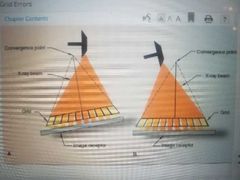
|
|
|
Off-level error |

When this error occurs, there is an undesirable absorption of primary radiation, which results in a radiograph with a decrease in exposure across the entire image |
|
|
|
Off-center grid error |
The X-ray tube must be centered along the central axis of a focused grid to prevent this. The center grid strips are perpendicular and become more and more inclined away from the center. This design coincides with the Divergence of the X-ray beam from the tube |
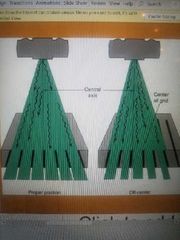
|
|
|
Off center grid (off-axis or lateral decentering) |
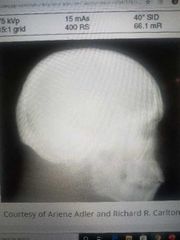
This error results in a decrease in exposure across the entire image |
|
|
|
Off focus grid error |
When a grid is used at a distance other than that specified as the focal range, this error resultsCauses grid cutoff along peripheral edges of the image Causes grid cutoff along peripheral edges of the image Causes grid cutoff along peripheral edges of the image |
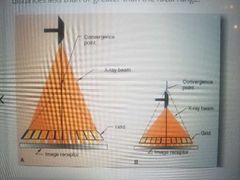
|
|
|
Off-focused grid error |
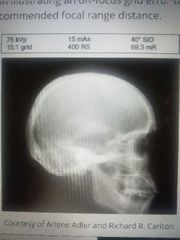
Results in Grid cutoff along the peripheral edges of the image |
|
|
|
Upside down grid error |
Causes severe peripheral grid cutoff. Radiation will pass through the grid along the Central Access where the grid strips are most perpendicular and radiation will be increasingly absorbed away from the center |
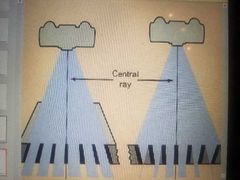
|
|
|
Upside down grid error |
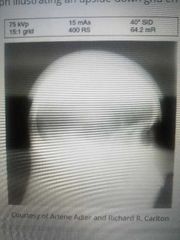
|
|
|
|
Moire effect |
Is a grid error that occurs with digital IR systems when the grid lines are captured and scanned parallel to the scan lines in the Imaging plate readers Can be prevented by using high-frequency grids design for computed radiography |

|
|
|
Grid errors |
Off level. Central Ray angulation across grid lines. Off center. Off focus. Upside down. Moire effect (grid aliasing) |
|
|
|
Air-Gap technique |
Alternative to grid use.
Scatter radiation is lost in air space between patient and receptor.
10 inch air gap has similar clean up of 15:1 grid.
SID needs to increase equal amount to maintain image Revolution |
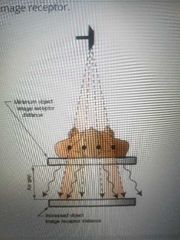
|
|
|
Air gap technique |
The _____ technique reduces the amount of scatter radiation reaching the image receptor |
|
|
|
Digital receptors, increase, 50 |
When _____ are used, increasing kvp values is strongly recommended. Use 15% rule and an _____ in kVp can be offset with a ___% reduction in mAs |
|
|
|
Selectivity |
Grids that absorb a greater amount of scatter then primary radiation are described as having a greater degree of |
|
|
|
Contrast Improvement Factor |
A scatter increases, contrast decreases, as will the... |
|

